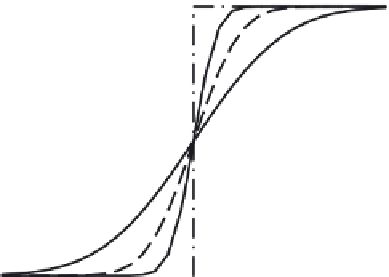Agriculture Reference
In-Depth Information
1.00
Time = 16
0.75
4 d
2 d
0.50
0.25
Time = 0
0.00
0
5
10
15
20
25
30
35
Distance, cm
FIGURE 3.3
Effect of molecular diffusion on solute transport with distance for 0, 2, 4, and 1 d.
dispersion phenomenon is due to various factors associated with the geom-
etry and flow characteristics of porous media. Generally, dispersion can be
attributed to the nonuniform flow velocity distribution during fluid flow in
porous media (Ogata, 1970, Nielsen, van Genuchten, and Biggar, 1986). In
porous media the porosity results from interconnected pores having differ-
ent size diameters and having different proportions. This results in different
water velocities attributable to the different pore diameters or the pore size
distribution of the porous medium. As a result, solutes in large pores travel
to a greater distance than solutes present in small pores.
In addition, within an individual pore, according to Poiseuille's law, there
is variation in velocity from the center of a pore (maximum value) to zero at
the solid surface. This is illustrated in Figure 3.4, which shows solute spread-
ing due to dispersion as well as diffusion (see Bear, 1972). According to
Poiseuille's law, a velocity distribution develops over time with an increase
in the advance or spreading of a solute front. Fluctuation of the flow direc-
tion or path due to tortuosity of the porous medium is another significant
factor that results in solute spreading.
Grain
Velocity
distribution
Grain
FIGURE 3.4
The spreading of a solute due to dispersion in porous media.








Search WWH ::

Custom Search